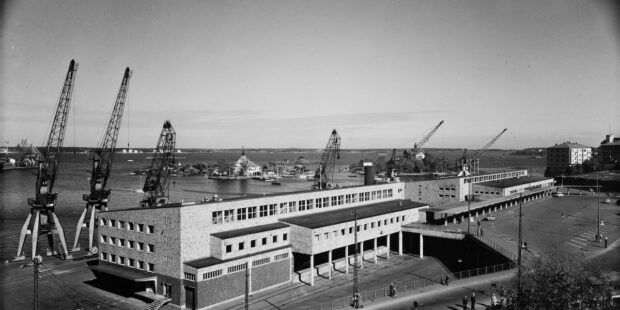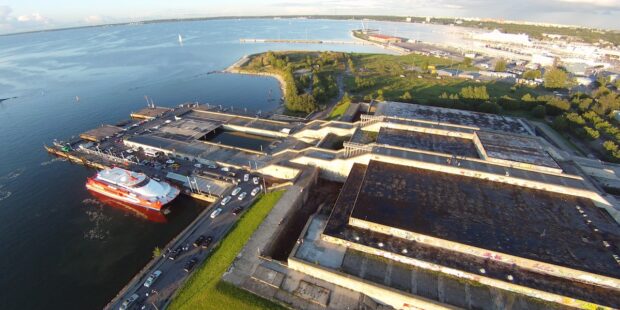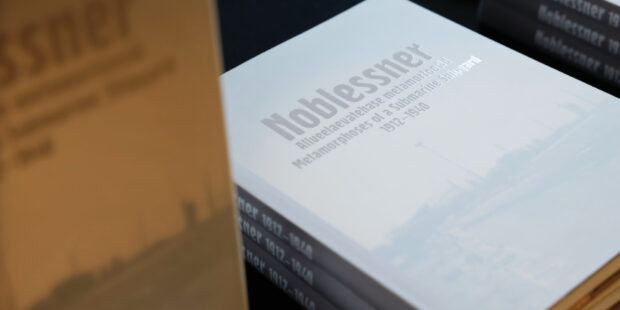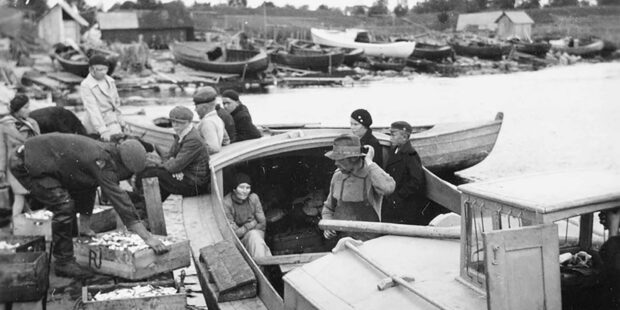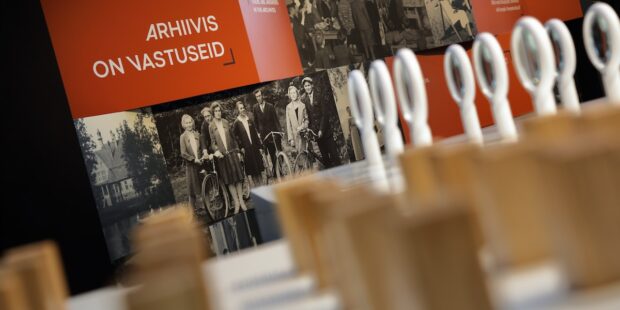The square of a thousand steps
Text Antti Sarasmo, Illustration archive of The Baltic Guide / Hannu Lukkarinen
The spring of 1988 was a hectic time. The Soviet Union was begin to fray at its edges. Politics was being talked about everywhere, and all the time. Estonia was at the forefront of the Soviet republics because it was the only Soviet republic where you could watch television from the capitalist world, and without a big language barrier. Finnish television broadcasts were a window to a different kind of reality, the kind people wanted.
“Old Town Days” are held every year in early summer in Tallinn. There are historical performances, or rather dramatized history, and various concerts. This was also the case in 1988. The stage was set up where it is today, at the end of Town Hall Square on the sea side. Estonia’s most famous bands and singers took to the stage.
The houses circling Town Hall Square echoed with the sound of electric guitars on the summer evening. The songs were political, in Estonia in 1988, there was only one style of music, a political song. A Finn wouldn’t even recognize all the songs as political, but the listeners in Old Town Square at that time recognized the message. Estonia’s non-violent struggle for independence had its prelude.
Something permanent
Borders are the most durable of human creations. Anywhere in the world, the boundaries of a farm or a city plot can be hundreds or even thousands of years old. Roads are created and disappear, houses are built and demolished, but the borders of plots and land, they seem eternal. Rarely does the border of a city or the border of a kingdom break the border of a plot of land or a farm, once demarcated, it is permanently marked.
Town Hall Square was created at the end of the 13th century, and the town hall, which gives the square its name, is Tallinn’s number one building, the place from which the numbering of Tallinn’s houses was formulated. Plots were measured at the edges of the square, and so the square is still its original size.
In the past, the city’s market “Vana Turg” (old market), took place in the square in front of the restaurant Olde Hansa. However, “Vana Turg” was small, so a new and bigger market was built to meet the needs of the growing city.
City Council
Medieval Tallinn was a city-republic. The formal ruler was the Grand Master of the Teutonic Order’s Livonian (present-day regions of Latvia and Estonia) branch. Although Tallinn was a republic, it was not a very democratic one.
Tallinn was a trading city, and, like other cities belonging to the Hanseatic League, it lived on foreign trade. Tallinn exported dried rye, which was produced at manors inland, and Tallinn brought salt and many other commodities that could not be produced in Tallinn.
The life of the city depended on the merchants doing foreign trade. There were 100–200 such single-family shop houses, and these members of the guilds were indeed the republicans of Tallinn.
Among the guilds of the city’s various trade unions, the most significant was the Great Guild, the guild of those engaged in foreign trade. About 25 aldermen were elected from the members of the Great Guild, and four of them were mayors. The aldermen formed the city government, i.e. the government of the city republic, and the mayors were the ministers of the city republic.
The Town Hall, with its hired scribes and other officials, was the centre of Tallinn’s administration. The jury or the persons appointed by it as judges for each case also sat in the courtroom. Trials were held outside the Town Hall, in the colonnade, and in the Hanseatic cities they were public. A fine was a common punishment, and if imprisonment was ordered, it was carried out in the City Council prison behind the Town Hall.
The towers of the city walls were not usually used as prisons, they were far too impractical for that. A hatch in the floor as the only entrance to the vaulted cellar required ladders or other arrangements. On the other hand, such a vaulted cellar was the most excellent storehouse, it was difficult for a thief who would have to use a rope to lift the booty from the opening in the ceiling, the opening that was also in the floor of the living room. Of course, there is information that the vaulted cellars of the towers were used as “pipes”, for example, when a larger group of robbers had been caught or a group who had tried to take over the city during a war.
Flogging was also common. Looking from the Town Hall, on the opposite side of the square, there is a round stone the size of a millstone with three holes. In the Middle Ages, a gallows was erected on it, where the punished received their prescribed lashes. The death sentence, or beating, was never carried out inside the city walls. The patron saint of the city did not like bloodshed in their territory. The site chosen outside the city walls for such punishments was somewhere near where the National Library of Estonia is located today.
In the Weighhouse, the jury determined the measurements, how much something weighed, how long, for example, a cubit was or what the volume measurements were. The samples of the measurements were kept in the Weighhouse, and people went there to get a certificate that the grain merchant’s weights were in accordance with the law or that the brewer’s pints were big enough. All that remains of the City Council’s Weighhouse are the borders drawn on the surface of the square.
People’s Town Hall Square
Every morning, when the gates opened, peasants came to the city to sell food. There was milk, cheeses, eggs, vegetables, i.e. everything that was produced in the countryside near the city. Town Hall Square was practically the only grocery store in Tallinn. At midday, the market trade stopped when the city’s servants swept the market clean.
Public life took place in the Town Hall Square. Parties were held there, court was held, and the townspeople met there. Around the market, there were shops of craftsmen and general traders. The Great Guild’s grain and salt merchants needed larger warehouses, and their houses were usually on Pikk and Lai streets, but there were enough other merchants on the sides of the market. Usually, the German merchants kept their shops on the ground floor and the Estonian country merchant in the vaulted basement of the house. At the entrance to the vaults were small sheds, a bit similar to the ones in the restaurant at the end on the Toompea side today. Actually, only Germans were allowed to trade, but Estonians were allowed small-scale resale to the Estonian population of the city, Estonian merchants, of course, bought their goods from a real German merchant.
In the Middle Ages, there were no taverns in the Town Hall Square, they were on the side streets, where they did not cause such a big disturbance. Today, Town Hall Square is full of terraces, and the houses bordering it are restaurants. The square’s use has changed, but the square itself remains the same, and the sound of thousands of footsteps can still be heard there every day.
Town Hall Square’s houses
Town Hall Square is approximately as it was during Tallinn’s golden age in the 15th century.
On the side facing Toompea, there is a house with an appearance that dates back to 1825. Originally two medieval houses were joined in the 1630s and then repaired once more. Opposite the town hall is a medieval-looking house, it is from 1921. Next to it on the right is a baroque house from the 1630s, with, of course, medieval cellars. Raeapteek, the city council pharmacy, in its current form, dates from 1441, and the upper floors from 1550–51.
The corner house on the sea side of the square was originally from the 14th century, but it got its current appearance in the 16th century. To the right of it is also a renovated medieval house, which became a state office building in the 19th century. The house was “renovated” so that the medieval character disappeared. Next to it is an authentic building, the City Council building, the first mention of which is from 1378. The office building housed Tallinn’s real estate register, and all real estate transactions had to be done on its premises. The house had a very large cellar, which served as the wine cellar of the Tallinn court until 1632.
The next house with three windows and three floors was originally a merchant’s house. The hatch of the winch storage has been preserved, as well as the assembly to which the pulley was attached when the goods were lifted into the storage. The house is originally from the 15th century, more windows were added later when the storage floors were converted into living rooms. The merchant’s house was inhabited on the first floor, the other premises were storage floors. Next to the house is a building from the 17th century, and the last building next to it, whgich originally dates from 1367, was renovated to meet the needs of “modern times” in 1665.
To learn more about this and similar topics
Great Guild
Merchants
Singing Revolution
Tallinn City Council
Tallinn History
Tallinn Town Hall
Tallinn Town Hall Square



